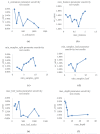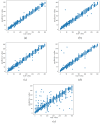Research on a Gas Concentration Prediction Algorithm Based on Stacking
- PMID: 33668797
- PMCID: PMC7956455
- DOI: 10.3390/s21051597
Research on a Gas Concentration Prediction Algorithm Based on Stacking
Abstract
Machine learning algorithms play an important role in the detection of toxic, flammable and explosive gases, and they are extremely important for the study of mixed gas classification and concentration prediction methods. To solve the problem of low prediction accuracy of gas concentration regression prediction algorithms, a gas concentration prediction algorithm based on a stacking model is proposed in the current research. In this paper, the stochastic forest, extreme random regression tree and gradient boosting decision tree (GBDT) regression algorithms are selected as the base learning devices and use the stacking algorithm to take the output of each base learning device as input to train a new model to produce a final output. Through the stacking model, the grid search algorithm is studied to automatically optimize the parameters so that the performance of the entire system can reach the optimal parameters. Through experimental simulation, the gas concentration prediction algorithm based on stacking model has better prediction effect than other integrated frame algorithms and the accuracy of mixed gas concentration prediction is improved.
Keywords: automatic grid search algorithm; ensemble learning; model fusion; regression algorithm.
Conflict of interest statement
The authors declare no conflict of interest.
Figures









Similar articles
-
A New Mixed-Gas-Detection Method Based on a Support Vector Machine Optimized by a Sparrow Search Algorithm.Sensors (Basel). 2022 Nov 20;22(22):8977. doi: 10.3390/s22228977. Sensors (Basel). 2022. PMID: 36433576 Free PMC article.
-
Heterogeneous ensemble learning for enhanced crash forecasts - A frequentist and machine learning based stacking framework.J Safety Res. 2023 Feb;84:418-434. doi: 10.1016/j.jsr.2022.12.005. Epub 2022 Dec 14. J Safety Res. 2023. PMID: 36868672
-
[Predicting Ozone Concentration in Hangzhou with the Fusion Class Stacking Algorithm].Huan Jing Ke Xue. 2024 Sep 8;45(9):5188-5195. doi: 10.13227/j.hjkx.202310221. Huan Jing Ke Xue. 2024. PMID: 39323137 Chinese.
-
Ensemble learning algorithm based on multi-parameters for sleep staging.Med Biol Eng Comput. 2019 Aug;57(8):1693-1707. doi: 10.1007/s11517-019-01978-z. Epub 2019 May 18. Med Biol Eng Comput. 2019. PMID: 31104274
-
Data-driven modeling and prediction of blood glucose dynamics: Machine learning applications in type 1 diabetes.Artif Intell Med. 2019 Jul;98:109-134. doi: 10.1016/j.artmed.2019.07.007. Epub 2019 Jul 26. Artif Intell Med. 2019. PMID: 31383477 Review.
Cited by
-
Gas Concentration Prediction Based on IWOA-LSTM-CEEMDAN Residual Correction Model.Sensors (Basel). 2022 Jun 10;22(12):4412. doi: 10.3390/s22124412. Sensors (Basel). 2022. PMID: 35746193 Free PMC article.
-
An Ensemble Method for Missing Data of Environmental Sensor Considering Univariate and Multivariate Characteristics.Sensors (Basel). 2021 Nov 16;21(22):7595. doi: 10.3390/s21227595. Sensors (Basel). 2021. PMID: 34833670 Free PMC article.
References
-
- Liu H., Luo D., Zhang Z. Odour Recognition Algorithms for Machine Olfaction System. J. Sens. Technol. 2006;6:154–158. (In Chinese)
-
- Zhu Y., Wang N., Xu L., Wu F. Machine Olfaction System Based on ABC-RNN. J. Wuhan Univ. (Sci. Ed.) 2019;3:290–296. (In Chinese)
-
- Murthy V.N., Rokni D. Processing of Odor Mixtures in the Mammalian Olfactory System. J. Indian Inst. Sci. 2017;97:415–421. doi: 10.1007/s41745-017-0045-1. - DOI
LinkOut - more resources
Full Text Sources
Other Literature Sources

